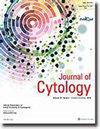肺腺癌的程序性死亡配体-1检测:细胞阻滞与活检的比较研究
IF 1
4区 医学
Q4 MEDICAL LABORATORY TECHNOLOGY
引用次数: 0
摘要
背景:免疫疗法目前是一种新的治疗选择,特别是在晚期非小细胞肺癌(NSCLC)的病例中。程序性死亡配体-1 (PD-L1)在肿瘤细胞中的表达是使用抗PD-L1单克隆抗体治疗非小细胞肺癌的主要依据。目的:本研究的目的是评估细胞块检测肺腺癌中PD-L1的效用,并比较细胞块和相应活检标本中PD-L1的表达。材料和方法:本研究是一个前瞻性的病例系列,包括20例非小细胞肺癌肺腺癌。研究中包括的病例对肺肿块进行了活组织检查,同时从细针吸细胞学(FNAC)样本中制备了细胞块。在Ventana Benchmark XT系统上使用单克隆PD-L1抗体SP-263进行PD-L1检测。PD-L1仅在肿瘤细胞中表达,在肿瘤细胞中细胞质或膜性表达>1%的病例被归类为阳性。结果:20%的病例(n = 4/20)的肿瘤细胞活检样本中检测到PD-L1表达。在相应的细胞块中,15%的病例的肿瘤细胞中检测到PD-L1表达(n = 3/20)。细胞块的敏感性和特异性分别为75%和100%。阳性预测值为100%,阴性预测值为94.12%。结论:PD-L1检测具有预测和预后意义。在细胞块样本中进行PD-L1检测是一种潜在的替代方法,特别是在活检组织很少或无法获得的情况下。本文章由计算机程序翻译,如有差异,请以英文原文为准。
Programmed death ligand-1 testing in adenocarcinoma lung: A comparative study of cell block versus biopsy
Background: Immunotherapy currently stands as a novel treatment option, specifically in cases of advanced non-small cell lung carcinoma (NSCLC). Expression of programmed death ligand-1 (PD-L1) in tumor cells forms the mainstay for the use of anti-PD-L1 monoclonal antibodies in the treatment of NSCLC. Aims: The objectives of the study were to assess utility of cell blocks for testing of PD-L1 in adenocarcinoma lung and to compare the expression of PD-L1 in cell blocks and the corresponding biopsy specimens. Materials and Methods: The current study was a prospective case series that included 20 cases of NSCLC–adenocarcinoma lung. Cases included in the study had biopsies performed from lung masses, along with which cell blocks were prepared from fine needle aspiration cytology (FNAC) samples. Testing for PD-L1 was done using the monoclonal PD-L1 antibody, SP-263 clone on the Ventana Benchmark XT system. PD-L1 expression was assessed only in the tumor cells, and cases with >1% expression, cytoplasmic or membranous, in tumor cells were categorized as positive. Results: PD-L1 expression was identified in the biopsy samples of tumor cells of 20% of cases (n = 4/20). In the corresponding cell blocks, PD-L1 expression was identified in the tumor cells of 15% of cases (n = 3/20). Sensitivity and specificity of cell blocks were 75% and 100%, respectively. Positive and negative predictive values were 100% and 94.12%, respectively. Conclusion: PD-L1 testing has both predictive and prognostic implications. PD-L1 testing in cell block samples is a potential alternative, specifically in cases where biopsy tissue is minimal or unavailable.
求助全文
通过发布文献求助,成功后即可免费获取论文全文。
去求助
来源期刊

Journal of Cytology
MEDICAL LABORATORY TECHNOLOGY-
CiteScore
1.80
自引率
7.70%
发文量
34
审稿时长
46 weeks
期刊介绍:
The Journal of Cytology is the official Quarterly publication of the Indian Academy of Cytologists. It is in the 25th year of publication in the year 2008. The journal covers all aspects of diagnostic cytology, including fine needle aspiration cytology, gynecological and non-gynecological cytology. Articles on ancillary techniques, like cytochemistry, immunocytochemistry, electron microscopy, molecular cytopathology, as applied to cytological material are also welcome. The journal gives preference to clinically oriented studies over experimental and animal studies. The Journal would publish peer-reviewed original research papers, case reports, systematic reviews, meta-analysis, and debates.
 求助内容:
求助内容: 应助结果提醒方式:
应助结果提醒方式:


